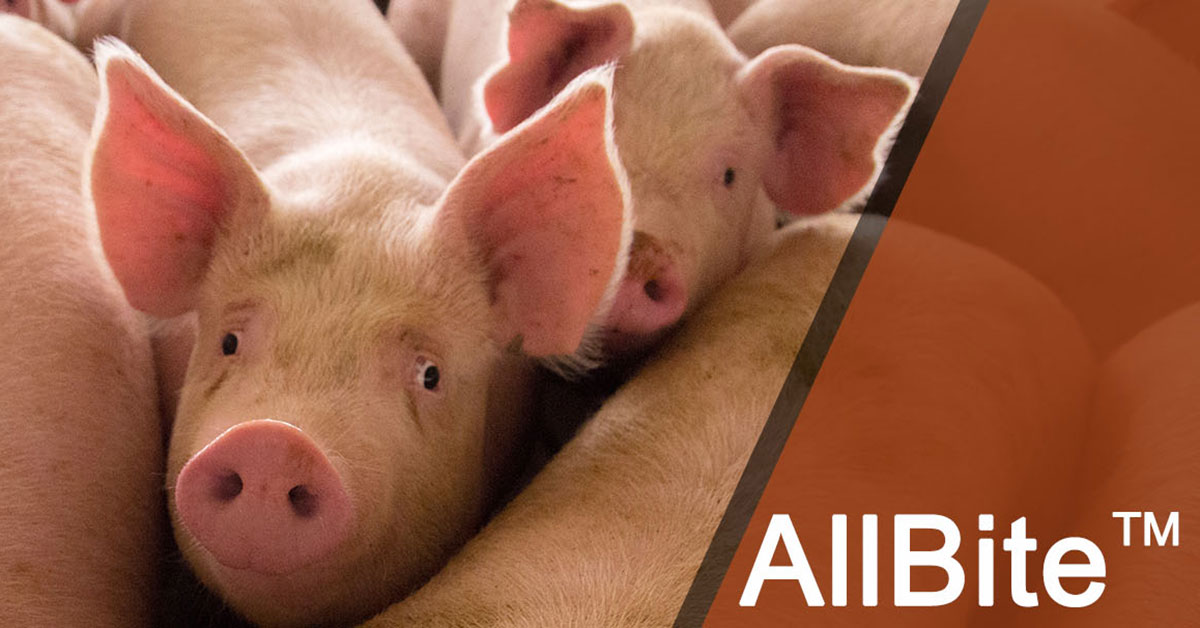
Tail-biting can affect either a single pig or an entire pen. It can be sporadic or chronic, but one thing is certain: Tail-biting is a vice behavior that frustrates animal care workers, farm managers, swine nutritionists and veterinarians alike. Solutions to tail-biting are often delayed and have inconsistent results. Fortunately, after three years in the making, Hubbard Feeds has developed a solution. Our new AllBite block is providing consistent, positive results by helping reduce tail-biting and other vice behaviors.
Hubbard Feeds senior swine nutritionist Jamie Pietig, who led the development of the AllBite block, noted that incidences of tail-biting seem to be on the rise.
“One challenge with tail-biting is the lag in response,” said Pietig. “By the time the reports of tail-biting get to me and I make changes in the diets and get that information back to the feed mill and then out to the farm, two weeks may have passed. A quick response time is one clear advantage of AllBite — we can place the block in the pen as soon as tail-biting is noticed.”
AllBite does more than just modify behavior, thanks to the ingredients within the block that help create a calming effect, similar to what is seen when magnesium oxide is added to the ration.
AllBite’s biggest advantages are its ease of use and flexibility; the benefits of utilizing this product can be applied to a wide range of situations. Setting up your AllBite block (pictured) is simple — it comes with a chain, so all you need to do is take it out of the box and hang it on the fence. Ensure that the block can move freely so pigs can chew on it from all sides.
Hubbard Feeds swine technical veterinarian Dr. Andrew Bents can attest to AllBite’s versatility. He was working recently with a gilt developer barn for a new start-up sow farm, and they were experiencing problems with both vulva- and tail-biting. As a solution, Dr. Bents hung AllBite blocks from hooks in the ceiling — and the biting stopped. When the gilts got accustomed to the blocks and started biting each other again, he moved the blocks from hook to hook to recapture the gilts’ interest.
Historically, one of the biggest frustrations with tail-biting mitigation products is their lack of consistent success in stopping this unwanted behavior. In field trials conducted by Hubbard Feeds, the AllBite blocks contributed to a 93% success rate in reducing or stopping tail-biting. The key is early identification and implementation of AllBite into pens where tail-biting is occurring. It is also crucial to use enough blocks based on the number of pigs in the pens.
“In our early field trial work, when producers didn’t at least use one block per 25 heads, pigs consumed it too fast and went back to tail-biting,” said Pietig. “It’s tempting to want to stretch the AllBite blocks across more pigs, but the key is to make sure all pigs have access to the block. I should also note that if the tail-biting is too severe, the likelihood of AllBite helping is decreased.”
There’s been a great deal of excitement generated around AllBite — from all types and sizes of farms.
“Tail-biting is a universal concern, and, as animal caretakers, the welfare of our pigs is a daily responsibility,” said Pietig. “Having a product like AllBite to quickly, conveniently and efficiently address these challenges is both encouraging and exciting.”
For more information on AllBite, visit www.hubbardfeeds.com/allbite or contact your local Hubbard Feeds representative.
- Log in to post comments
